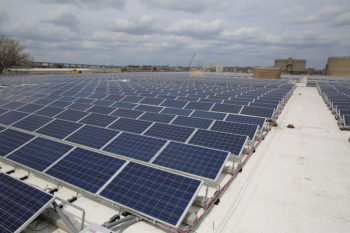
The proposed zoning text amendment will help increase the available space for solar panels, among other things. Credit: NYC DEP
Mayor Adams proposed a new city amendment to reduce our carbon footprint by removing red tape around certain zoning codes. On June 1, 2022, New York City Mayor, Eric Adams, proposed three new citywide text amendments to improve the City’s equity, sustainability, and housing. Mayor Adams believes current zoning codes have certain restrictions that could be diminished or completely eliminated in order to fulfill these goals. One of the proposed amendments, “Zoning for Zero Carbon,” will attempt to (1) remove red tape in deploying new clean energy storages and uses, (2) facilitate building retrofits.
Deploying New Clean Energy Storage
The zoning code prevents the installation of electric vehicle charging systems in all residential areas and some commercial areas. In a society where the desire to reduce carbonization is immense, such zoning codes are restricting. According to a recent census, nearly 1.4 million households own cars (some owning more than one car), of which less than one percent are electric. By allowing the installation of electric vehicle charging systems in places more convenient for people, i.e., in residential areas where people more frequently use cars, people may feel more inclined to purchase electric vehicles and contribute to reducing our carbon footprint.
Facilitating Building Retrofits For Sustainability
NYC zoning has many restrictions for the installation of solar energy systems. Such restrictions include where, how tall, how big, and in what surface area the solar systems can be built. The zoning code heavily restricts building owners who want their buildings to be more energy efficient and sustainable, because solar energy systems are restricted to at most 25 percent of a building’s rooftop surface area or at most 20% of the surface area of a building’s wall. Mayor Adams asserts that, by removing red tape around these zoning codes for sustainability, there will be an increase in jobs. With more people desiring more cost-efficient energy sources for their buildings and more surface area on roofs and walls available for solar panel installations, more workers will be needed to install them. This will give people from denied communities the opportunity to learn new skills and receive the training needed to get them off the street and into a more productive, healthy work environment. Invariably, the economy will flourish while our carbon footprint becomes fainter and fainter.
Eliminating Barriers to the Electrification of Building Systems
The zoning code has many restrictions for the installation of mechanical units such as heat pumps and HVAC systems. Such restrictions include the size, location, enclosing, and screening of the mechanical units that can be installed. Aside from that, different permits, drawings, and photos may be required to qualify for installing any mechanical units. Further, each mechanical unit comes with its own set of requirements as set out by, not only the New York City zoning codes, but also NYS/Con Ed Clean Heat requirements and the Department of Housing Preservation and Development specifications. By eliminating these requirements for installing the various mechanical units, people may be more inclined to including such energy-saving, cost-effective, carbon-reducing mechanical units in their buildings.
Upon the announcement of the amendment, Julie Tighe, president of the New York League of Conservation Voters stated, “Zoning for Zero Carbon is a forward-looking plan to ensure the city continues to innovate and build with a focus on eliminating greenhouse gas emissions and fossil fuels. By removing obstacles to deploy new clean energy storage and electric vehicle charging infrastructure, and making it easier to retrofit buildings for sustainability, the city is removing barriers to clean, green progress. The League appreciates the mayor and Department of City Planning for this creative step to move us toward a greener New York City.”
Next Steps
On June 14, 2022, Mayor Adams released his housing plan, in which he highlighted that the changes from the Zero Carbon Zoning amendment will “support innovation in new buildings and the adoption of sustainable practices at scale.” The housing plan did not provide further details about the proposed text amendment, but CityLand will provide more information about the housing plan at a later date.
There is no timeline for when the drafted Text Amendments will be released and begin the public review process. CityLand will give all sides a voice to express thoughts about the amendments once they are drafted.
This article is part of CityLand‘s ongoing series about the proposed zoning text amendments announced on June 1st by Mayor Adams.
By: Malka Amar (Malka is a CityLaw intern and New York Law School student, Class of 2023.)


The city should also allow micro-car EVs.
NYC speed limits are now 25mph for almost all streets, <40mph for the fastest major bridges, and very rarely 50mph on major arteries like the Henry Hudson Highway uptown of the George Washington Bridge.
Current micro-car EVs – commonly used all over the world, except in most of America – can handle the minimum speed limits on all NYC roads.
They have equal or better acceleration to internal combustion vehicles, and safety is adequate given their lower speeds, and anyway, certainly far better than for motorcycles, e-bikes and other vehicles allowed on most or all streets.
They typically have 1-2 seats and enough storage area for routine trips to the grocery store etc.
Many micro-car EVs can park perpendicular to the curb, thereby freeing up major amount of parking space, even providing the possibility of micro-car only parking areas to encourage these cheap efficient modes of transportation.
They can be recharged in under an hour, often without special high-capacity fast chargers.
It's high time for NYC to join the rest of the world's urban centers.